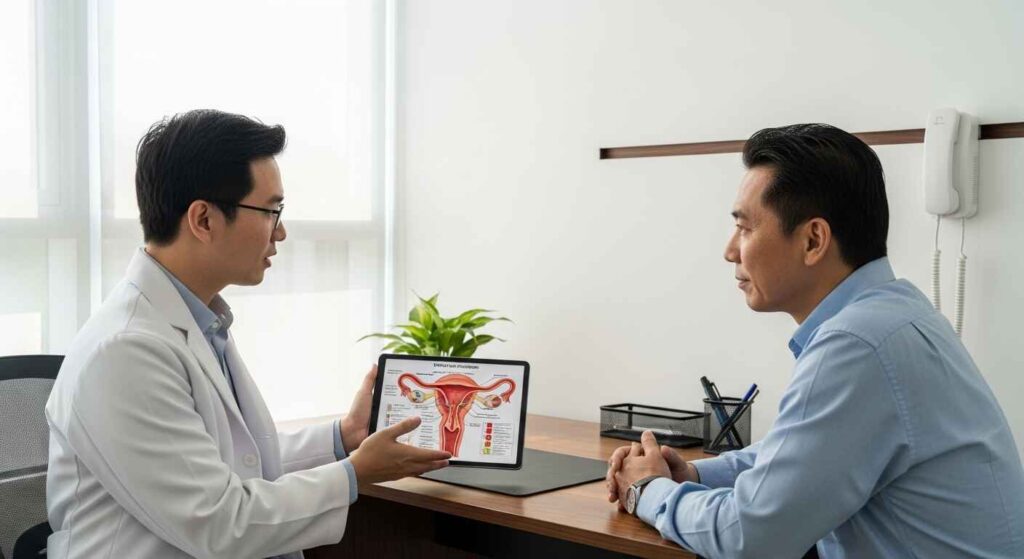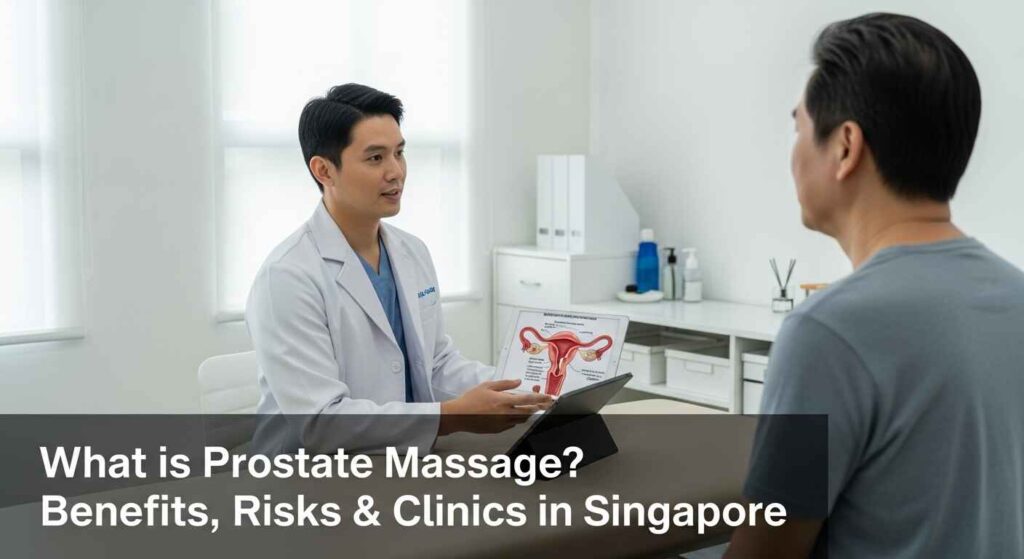Prostate massage is a gentle internal technique performed through the rectum that may ease pelvic discomfort or prostatitis-like symptoms for some men. Results are not the same for everyone, and it’s not a cure—there are real risks if it’s done roughly or without strict hygiene.
If you’re exploring this in Singapore, keep safety first: consult a doctor or urologist to rule out red flags, and only book with licensed medical or pelvic health providers. You should feel informed, in control, and free to stop at any time.
What is the prostate?
The prostate is a small gland that sits just below the bladder and in front of the rectum. It helps make seminal fluid. As men get older, the prostate can swell (BPH) or become inflamed (prostatitis). These changes may lead to pelvic pressure, pain, or urinary problems such as a weak stream or frequent trips to the toilet.
What is Prostate Massage?
Prostate massage involves gentle pressure on the prostate through the rectal wall using a gloved, lubricated finger or a medical tool. Some people hope it eases pelvic pressure or helps with prostatitis-type symptoms. Doctors have mixed views; good studies are limited, and results differ from person to person.
How a Session of Prostate Massage is Done?
This session includes:
- Screening & consent: You share your symptoms and history. The clinician explains benefits, risks, and other options, then asks for informed consent.
- Preparation: Empty your bladder and, if possible, your bowels. The clinician uses new gloves and single-use supplies.
- Positioning: Side-lying with knees bent, or standing and leaning forward.
- Lubrication & entry: Slow, careful insertion with a water-based lubricant.
- Gentle strokes: Light pressure in short passes, with frequent check-ins about your comfort.
- Monitoring: The session ends immediately if you feel sharp pain, dizziness, or bleeding.
- Aftercare: You receive advice on hydration, hygiene, and warning signs.
Possible benefits (what we know and what we don’t)
Evidence is mixed. Keep expectations realistic.
| Goal | What people hope for | Plain-English view |
| Pelvic pain / prostatitis-type symptoms | Less pressure, fewer flare-ups | Some report short-term relief; no guaranteed results. |
| Urinary flow in BPH | Easier starting, fewer night trips | No strong proof for long-term BPH relief; medical care is usually first-line. |
| Sexual comfort | Less discomfort, more confidence | Experiences differ; clear evidence is limited. |
| “Drainage” | Clearing fluid from the gland | This idea is debated; hygiene and safety matter more than “drainage.” |
Risks and side effects
The prostate and rectal tissues are delicate. Risks rise with rough technique, poor hygiene, or untrained providers.
- Pelvic or rectal pain/soreness
- Bleeding (rectal, or blood in urine/semen)
- Infection
- Haemorrhoids flare-ups
- Worsening of hidden problems (for example, cancer or acute infection)
Get urgent care if you develop a fever, severe pain, heavy bleeding, or trouble passing urine.

Who should avoid it (or get explicit medical clearance)
- Suspected or confirmed prostate cancer
- Acute prostatitis (active infection)
- Recent urological/rectal surgery or biopsy
- Severe haemorrhoids, fissures, or rectal bleeding
- Bleeding disorders or strong blood thinners
- Severe pain even with very light pressure
Legal and safety notes in Singapore
Healthcare and massage services are tightly regulated. Sexual services are illegal. Only consider providers who are properly licensed, follow strict hygiene, and use informed consent with clear records. When unsure, see a GP or urologist first for a medical opinion.
Best Clinics & Services in Singapore
These options focus on urology (medical care) and pelvic health physiotherapy. They can assess symptoms, rule out red flags, and discuss whether any internal manual work fits your situation.
1) Singapore General Hospital (SGH) — Urology / Prostate Centre
Comprehensive public-hospital urology service covering prostate problems from evaluation to treatment and follow-up. Good for full medical work-ups (BPH, prostatitis assessment, imaging, procedures).
When to consider:
- Red-flag symptoms (fever, severe pain, visible blood)
- Long-standing urinary issues or complex cases
- You prefer a team-based public hospital pathway
2) AARE Urocare — Dr Fiona Wu (Private)
AARE Urology clinic managing bladder, kidney, and prostate conditions; lists “Prostate Health” and men’s pelvic concerns among clinical interests. Personalised care with prior public-hospital experience.
When to consider:
- Persistent pelvic symptoms, and you want a focused urology review
- You prefer a single-consultant setting
3) Advanced Urology (Private)
Large private urology group with multiple clinics. Handles prostate health end-to-end (BPH, prostatitis assessment, diagnostics, and modern minimally invasive options such as Rezūm where suitable). Faster scheduling than public settings.
When to consider:
- You want private care and shorter wait times
- You’re weighing procedure options for BPH or seeking a second opinion
4) City Osteopathy & Physiotherapy — Men’s Pelvic Health
Pelvic health physiotherapy for men (pelvic floor dysfunction, pelvic pain, bladder control). Focus on assessment, muscle relaxation/coordination, and home plans. Good first-line conservative option for chronic pelvic pain/CPPS.
When to consider:
- Your doctor suspects pelvic floor muscle involvement
- You want a conservative plan before invasive options
Costs and session length
Prices depend on clinic type, first consults, and follow-ups. Public hospitals usually cost less but may have longer waits. A typical path is: consult + assessment → tests if needed → a tailored plan (often pelvic physio, medication, or other care). Any internal manual work, if used at all, is normally short and gentle within a wider plan.
What to do before and after
Before your visit
- Write down your symptoms, triggers, and duration
- Bring a list of medicines and recent tests
- Avoid alcohol; try to keep bowel movements regular
- Agree on simple “stop” words with the clinician (“Stop”, “Pause”)
After your visit
- Hydrate and rest that day
- Mild soreness can happen; a warm compress can help
- Seek care fast for fever, heavy bleeding, severe pain, or difficulty urinating
Safer alternatives to consider (often first-line)
- Medical review by a GP/urologist to rule out infection, stones, or BPH
- Pelvic floor physiotherapy (relaxation, biofeedback, trigger point work)
- Medications for prostatitis/BPH, where appropriate
- Lifestyle steps: hydration, less caffeine/alcohol, bowel regularity, stress care, gentle activity
- Heat therapy: warm sitz baths for comfort
Conclusion
Prostate massage is a narrow, clinical technique—not a shortcut or a cure. A few people feel short-term relief, but results differ, and there are real risks if it’s done roughly or without proper hygiene. In Singapore, the safest path is simple: start with a GP or urologist, rule out red flags, and try pelvic floor physiotherapy as your first-line plan. If internal manual work is suggested, it should be gentle, brief, and part of a wider treatment plan—not a stand-alone fix.
Read more:
Eye Bag Removal in Singapore: Costs, Treatments & What to Expect 2025
Frequently asked questions (FAQ)
Here are the FAQs:
Is prostate massage in Singapore painful?
It shouldn’t be. You may feel pressure or mild discomfort. Sharp pain is a stop sign.
How often should it be done?
There’s no set schedule. Many clinicians focus on broader pelvic health rather than frequent massage.
Can it cure prostatitis or BPH?
No single technique is a cure. It may ease symptoms for some, but results vary.
Is self-massage safe?
Home attempts carry risks like injury and infection. Speak to a clinician first.
Will insurance cover the prostate massage costs in Singapore?
It depends on your diagnosis and provider type. Ask your insurer before booking.

